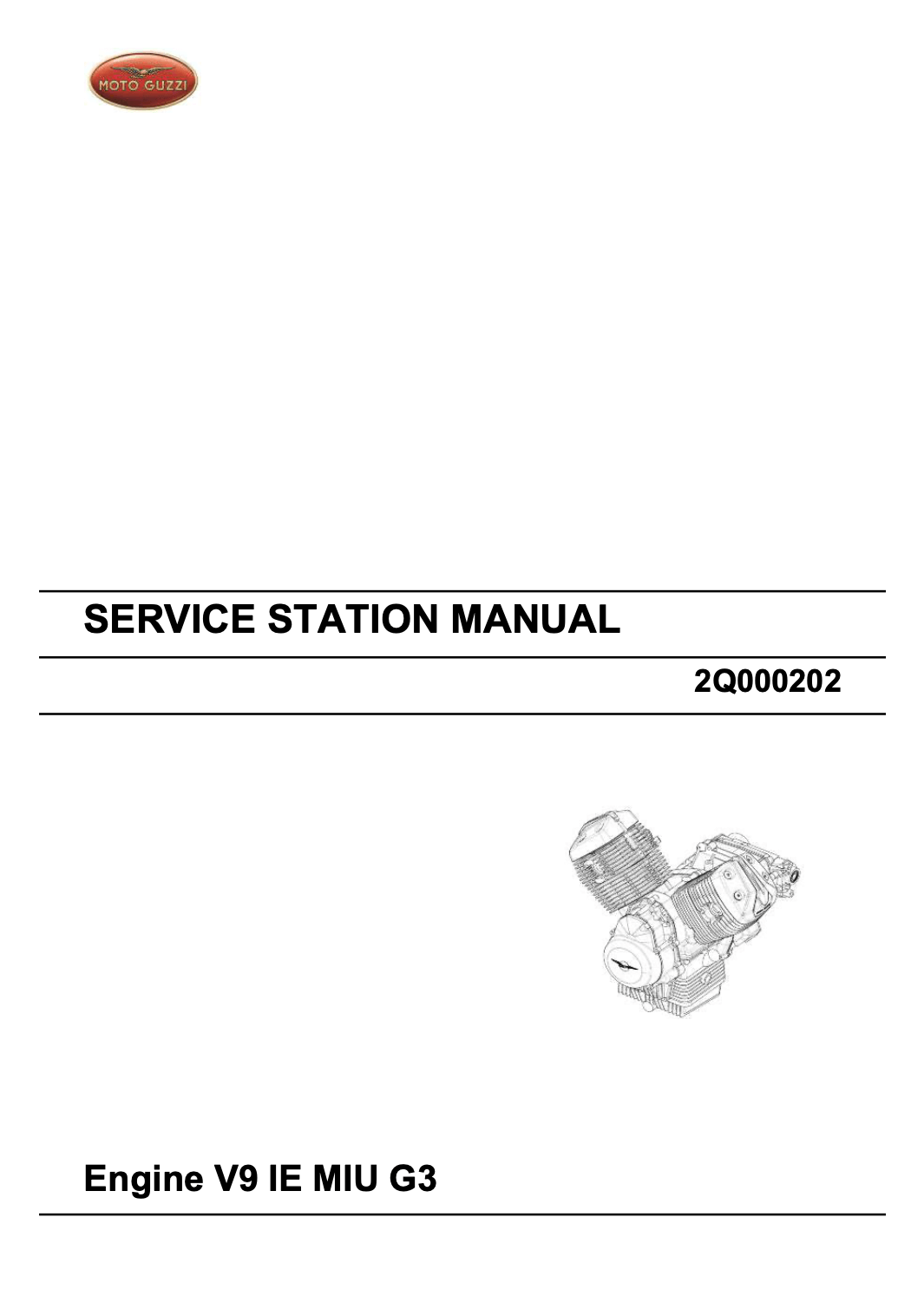Complete PDF version of the Service Manual for the Moto Guzzi Engine V9 IE MIU G3. A MUST for every Moto Guzzi owner.
This manual of f0r the ENGINE only.
Download: Immediately after payment!
OEM Original factory workshop manual.
Models covered by this manual: All V9 i.e.
Number of pages: 105 pages
Table of contents:

This PDF repair manual can be downloaded right after the payment process in complete, on the device of your choice. You will also receive the download link by email along with your receipt.
We do not offer printed manuals, for the following reasons:
- it is more eco-friendly to use a digital version
- your manual never gets dirty or greasy
- you can always choose to print the specific page(s) you need to work on your bike
- you receive your manual immediately after payment
- it is searchable

Moto Guzzi Engine V9 IE MIU G3
Now that Moto Guzzi‘s tiny block V-Twin has reached full maturity—with its last expansion to the 850ccs of the newest V9—it’s worth revisiting the engine’s history.
After the failure of the Benelli 254 and the fairly brief lives of the Moto Guzzi 350 Four and Benelli 504, the late Alejandro De Tomaso ordered this engine. Mr. De Tomaso got the De Tomaso Automobili technical department to work on a twin-cylinder 350/500cc engine based on the same 90-degree, transverse Vee that had contributed to the Moto Guzzi reputation from 1965 circa 1975 (when the original 703cc V7 was officially introduced at EICMA).
It was a wise decision—as was often the case with Mr. De Tomaso—but the project was hampered by the technical staff’s lack of expertise as well as technical shortcuts pushed by De Tomaso, who was not an engine specialist. It didn’t help that the legendary Moto Guzzi Chief Project Engineer Giulio Cesare Carcano departed as soon as Mr. De Tomaso took charge.
Among other things, the Argentine entrepreneur insisted that the unsuccessful Benelli 254 project’s con-rods be used on the new 350/500 twin. The De Tomaso engineers used a Heron style combustion chamber, inspired by the success of the Moto Morini 350. However, they did not fully research the entrance ports and combustion chamber layout (in order to obtain the correct swirl turbulences). In a comparative test I conducted at the time between the Moto Morini 350, the Ducati Pantah 350 XL, and the Moto Guzzi 350 Imola, the latter came in dead last in every category.
Seizures afflicted both the V35 (66mm bore x 50.6mm stroke) and the V50 (74mm bore x 57mm stroke). This was owing to the usage of connecting rods from a failed Benelli 254, which forced the piston to spend the majority of its stroke within the crankcase—the cylinder being so short that it only had two cooling fins. The next advancement was to V65, which was still substantially oversquare at 80mm x 64mm. Longer rods were eventually introduced.
The V65 was designed with both normal Heron and four-valve-per-cylinder thermodynamics, with the latter producing 60 horsepower. It was known as the V65 Lario. The Lario was viewed as a junior Le Mans by many, but it never provided the performance expected—its pushrod-and-rocker valve train was plagued by damaging valve-float issues, and the chassis seemed hopelessly imprecise.
The V75, the 744cc variant made by stroking the V65 from 64 to 74mm while preserving the 80mm bore, was born through this series of erroneous steps. The rod’s center-to-center measurement was enlarged to 130mm, and performance was regulated to restore the long-established Moto Guzzi dependability. The V75 withstood the several changes in Moto Guzzi ownership that happened in the 20 years leading up to the present owners, the Piaggio Group.
The bike was entirely restyled and called the V7; it became the best-selling model among all Moto Guzzi models. The engine was largely modified by using a single 38mm throttle body and the associated Y-shaped inlet manifold with extremely long runners, which contributed to better low-end performance and flexibility. Power was rated as 48 hp at 6,200 rpm, with peak torque of 44.2 lb.-ft. at 2,800 rpm.
The Moto Guzzi small block has got its first dramatic makeover in 40 years. The research began because it was required to increase displacement in order to maintain the same power level while meeting the stricter Euro 4 emission criteria. But things took a turn for the worst.
The new Moto Guzzi V9 is here. By extending the bore to 84mm and the stroke to 77mm, the displacement was raised from 744 to 853cc. Although the crankshaft has been changed, the connecting rods have stayed at the same 130mm center-to-center measurement, which is becoming a touch short in comparison to the increased stroke. Dr. Giulio Cesare Carcano, who used 150mm rods on his initial 70mm stroke, 700cc V7, could disagree. However, the compactness of Guzzi’s V7 and V9 models has always been a focus.
The V9 engine is not only small, but extremely light, weighing just 96.3 pounds, or 5.5 pounds more than the V7. The most drastic adjustment has been made to the thermodynamic design. The Heron-style combustion chamber has been replaced by a genuine hemi design.
This is not the first time the small-block Guzzi V-Twin has gotten a design of this sort. Umberto Todero, a long-serving Giulio Cesare Carcano employee, created a unique variant of the V75 in the late 1980s. Given the original 700cc V7’s 80mm bore, he converted the previous design to the tiny V75 to give life to a specific variant suitable for lightweight aircraft and drones. This highly unique model of the V75 was believed to function rather well, and it was developed and sold in limited quantities to the Israeli Army, who used it to power a surveillance drone. It’s unclear why it was never used on Moto Guzzi V75 vehicles.
The V9 has substantially bigger valves than the V7: intake 40.5mm (vs. 33mm) and exhaust 35.5mm (compared to 29mm). The valves are positioned at a 56-degree angle, which is extremely similar to the geometry chosen by Dr. Giulio Cesare Carcano for his original V7 and related evolutions. The combustion chamber has a tidy and compact hemi profile with the required annular squish area. The compression ratio is 10.5:1, which is the same as on the V7. In comparison to the Carcano engine, the V9 employs polidyne cam profiles (which did not exist in the 1960s) with mild lift (for simpler maintenance and longer valve train life) and nearly no overlap.
In order to satisfy Euro 4 emissions with a relatively tiny catalytic converter, this was chosen to ensure the most thorough combustion of the inhaled charge and to prevent any unburned hydrocarbons from escaping from the cylinders. The V9 has an essentially identical exhaust system as the V7 and breathes via the same single 38mm throttle body.
It produces 55 horsepower at 6,250 rpm and 45.7 pound-feet of peak torque at 3,000 rpm. The power and torque profiles give a smooth response over a wide rpm range, as I discovered firsthand while riding the bike through the Alpine passes that tower over Mandello del Lario. Moto Guzzi finished powertrain development by using a bigger diameter, single-disc clutch and a new double-U-joint driveshaft that clears the thicker rear tire. The chassis was also upgraded, although the frame structure remained mostly same. The wheelbase is now 57.7 in. long, up from 57 in. before, and the front wheel is 0.8 in. closer to the bike’s center of gravity. This, together with the use of a 1.5-inch longer swingarm, shifted additional weight to the front. The steering responsiveness, agility, and feedback were substantially enhanced when combined with a reduction in steering rake from 27.5 degrees to 26.4 degrees. The Moto Guzzi V9 Roamer is the greatest lightweight motorcycle ever made.
Source: Cycle World

